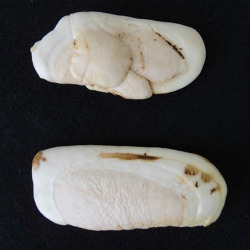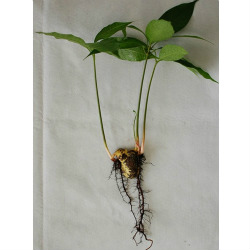Monoembryonic and Polyembryonic Mango
The secret of mango seeds !

Mango embryo
(embryo tissue removed from a seed by peeling the skin)
Top: 3 embryos of a polyembryonic seed
Bottom: a single embryo in a monoembryonic seed

Germinated polyembryonic seed of mango
Inside a plant seed is a tissue called an embryo. The embryo absorbs nutrients from the seed's endosperm, grows, germinates, and develops roots to become a plant body. Normally, a single plant is reproduced from a single seed, and is called “monoembryonic” seed. On the other hand, there are seeds that reproduce multiple plant bodies from a single seed, and these are called “polyembryonic” seeds.
There are “monoembryonic” and “polyembryonic” cultivars of mango, and this trait is important in classifying, using, and breeding mango. In general, cultivars originating from India and its surrounding areas, where mangoes originated, are more likely to be monoembryonic, while those originating from Southeast Asia are more likely to be polyembryonic.
The embryos of “monoembryonic” seeds are the result of hybridization and carry genetic information from both the female and the male parent, and the resulting plants are hybrids and do not bear the same fruit as their parents.
On the other hand, in the multiple embryos of a “polyembryonic seed”, only one embryo (the hybrid) is the result of crossbreeding. The remaining embryos are called "pearl-centered embryos," which contain only the genetic information of the mother, and are so-called nutritionally propagated clones that produce the same fruit as the mother.
In order to increase the number of seedlings of a particular mango cultivar, nutrient propagation is generally done by grafting or cutting. However, in the case of polyembryonic cultivars, cloned individuals of the mother can also be selected from "seedlings" grown from seeds and used as seedlings. On the other hand, if you want to grow a new cultivar, you need to select a plant body of cross-embryonic origin as material.